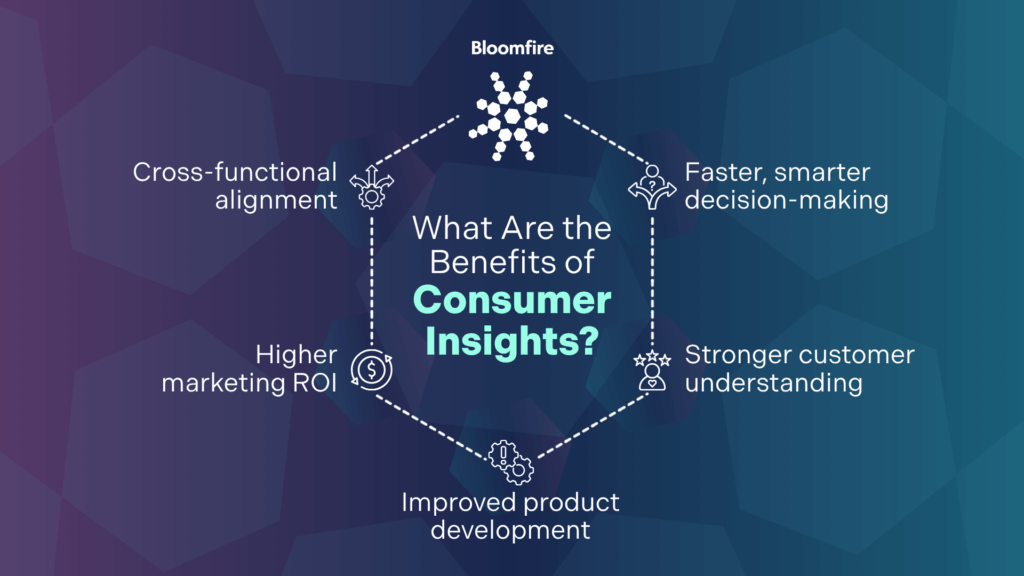Activating Consumer & Market Insights with Enterprise Intelligence

A few years ago, I wrote about building an insights engine—a system designed to transform scattered data into meaningful foresight. Since then, the stakes have only gotten higher. Today, consumer and market insights aren’t just competitive advantages. They’re strategic necessities. When change seems to move faster than planning cycles, insights have become the growth engine that companies can’t afford to stall.
In the past couple of months, I’ve been posting about the concept of Enterprise Intelligence—the intersection between knowledge management (KM), enterprise search, and business intelligence. But what does that have to do with consumer and market insights?
This convergence will change the level of access and capabilities the average company will have to connect insights generated from the market, customers, consumers, and even employees, turning them into strategies, innovations, and actions that drive growth.
In this post, I’ll talk a little about consumer and market insights over the years, how important activating them is to a company’s operational and financial health, and how their intersection with Enterprise Intelligence will become the next paradigm shift for growth-focused companies.
Why Insights Drive Performance
It’s no longer enough to rely on static reports. In today’s market, decisions need to be backed by real-time insights.
Insights play a pivotal role in:
- Understanding shifts in buyer behavior
- Informing go-to-market strategies
- Guiding product development
- Aligning teams across functions with a shared view of the customer
According to the Value of Enterprise Intelligence report, 89% of employees say they rely on input from others to do their job effectively. Delays in accessing those insights slow down decisions and dilute their quality. When teams can’t find or trust the knowledge they need, you don’t just lose time—you lose momentum.
That’s why strategic organizations are embracing principles of Enterprise Intelligence—treating knowledge as a managed asset that fuels everything from product cycles to campaign performance.
Insights That Fuel Growth
See how Bloomfire’s insights platform accelerates product cycles and drives ROI
Learn More
What Are Consumer Insights?
Consumer and market insights are actionable interpretations of behavior, preferences, and motivations derived from data. Where raw data shows what happened, insights explain the why behind it.
Examples of consumer and market insights include:
- Why first-time buyers abandon their carts
- What emotional triggers increase brand loyalty
- How pricing perceptions vary across markets
What Are the Benefits of Consumer Insights?
Here are five key ways consumer insights drive business value:
- Faster, smarter decision-making: Insights reduce guesswork and inform strategic planning based on real behavior, not assumptions.
- Stronger customer understanding: They help uncover motivations, preferences, and pain points that drive more relevant offerings.
- Improved product development: Consumer feedback and behavioral data guide features, formats, and pricing strategies that resonate.
- Higher marketing ROI: Targeting becomes more precise, campaigns become more effective, and customer acquisition costs decrease.
- Cross-functional alignment: When insights are shared broadly, teams—from product to sales to customer service—can act in concert.
By embedding insights into decision-making processes, companies gain a sharper competitive edge and a more straightforward growth path.

The Hidden Costs of Missed Insights
Here’s the catch: most companies are already generating an insights engine, but aren’t activating them. When insights live in silos, PowerPoints, or tribal knowledge, the cost is real.
From the Value of Enterprise Intelligence report:
- 65% of employees spend 5+ hours a week recreating information
- Searching for answers consumes up to 8.5 hours per employee, per week
- Organizations waste millions in productivity loss, rework, and delayed decisions
One global confectioner turned this around using Bloomfire to centralize 10,000+ market research reports and data subscriptions. That single change unlocked $3.4M in annual productivity gains and shortened their time-to-insight by days.
In short: your company already has the fuel. What it needs is ignition.
Enterprise Intelligence: From Search to Signal
Enterprise Intelligence shifts the model from passive repositories to active orchestration.
Instead of requiring employees to hunt for insights, systems surface knowledge at the point of need. Instead of requiring employees to hunt for insights, an insights platform surfaces curated knowledge at the point of need. AI tools like Bloomfire’s Enterprise Search and Author Assist help deliver trusted answers in real time—not by scraping the web, but by contextualizing your company’s knowledge.
For insight teams, that means:
- Less time prepping decks, more time analyzing what matters
- Reduced duplication of effort
- Increased influence in strategic conversations
This is what separates Enterprise Intelligence from traditional knowledge management. It isn’t about storing more. It’s about surfacing better.
For business units, it means:
- Faster product development
- More aligned go-to-market decisions
- Stronger market differentiation (Enterprise Intelligence accelerates product development by reducing time to insight and enabling reuse over rework.)
The Future of Consumer Insights Is AI-Augmented
The future of consumer and market insights isn’t about gathering more data; it’s about activating the right insight at the right time. As AI continues to reshape how we work, it’s redefining how insights are created, surfaced, and scaled across the enterprise.
AI for consumer insights goes beyond dashboards and static reporting. It enables systems that:
- Analyze behaviors and detect sentiment shifts
- Surface contextualized recommendations automatically
- Deliver insights proactively, in the flow of work
But AI without governance is just automation. That’s why next-generation insight engines will rely on Enterprise Intelligence: systems that combine AI with curated, trusted internal knowledge, ensuring accuracy, relevance, and strategic alignment.
A future-ready organization with Enterprise Intelligence will:
- Maintain a self-healing knowledge base, flagging outdated or conflicting content, and continuously refining itself to deliver high-quality insights
- Enable real-time, contextual insight delivery at every decision point
- Foster a culture of knowledge activation, where insights power not just strategy, but execution
Soon, insights won’t just inform strategy, they’ll be the strategy. AI may power the engine, but your knowledge infrastructure determines how far and fast you’ll go.
Make Insights the Center of Your Growth Strategy
The next wave of growth isn’t about more dashboards or fragmented reports. It’s about activating insights quickly, aligning teams around shared knowledge, and enabling faster, smarter decisions. The most competitive organizations aren’t just gathering information but moving it forward, turning insight into execution.
If your teams are still searching, second-guessing, or stalling for answers, it’s time to rethink your approach. Building a culture and system of Enterprise Intelligence ensures your most valuable knowledge isn’t just stored—it’s fueling every decision, product, and interaction.
Insights are your fuel. Enterprise Intelligence is the engine. It’s time to get moving.
Discover the ROI of Insights
See how Enterprise Intelligence improves speed, strategy, and market share
Read the Report
Enterprise AI Search: Definition, Benefits, and Evolution

The Benefit of Company-Wide Knowledge Management in 2026

Are You Making These Common Knowledge Sharing Mistakes?

Estimate the Value of Your Knowledge Assets
Use this calculator to see how enterprise intelligence can impact your bottom line. Choose areas of focus, and see tailored calculations that will give you a tangible ROI.

Take a self guided Tour
See Bloomfire in action across several potential configurations. Imagine the potential of your team when they stop searching and start finding critical knowledge.